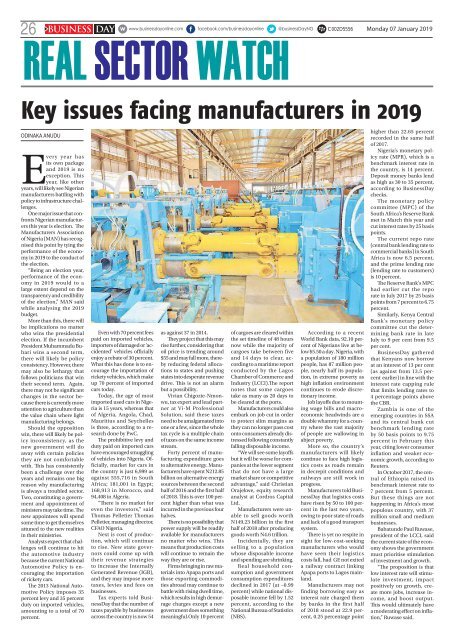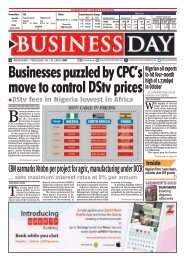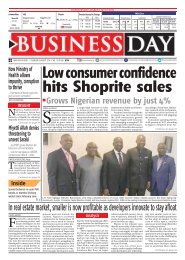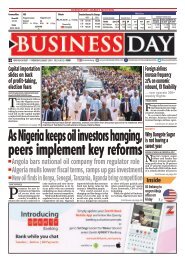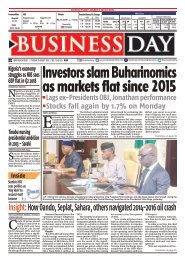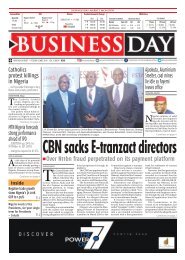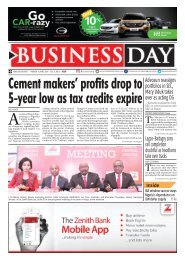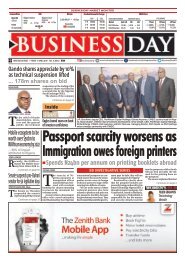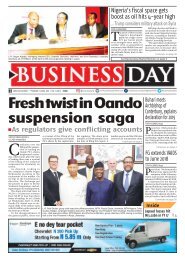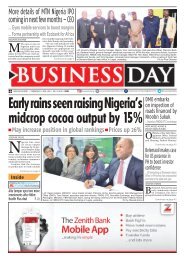BusinessDay 07 Jan 2019
Create successful ePaper yourself
Turn your PDF publications into a flip-book with our unique Google optimized e-Paper software.
26 BUSINESS DAY<br />
C002D5556 Monday <strong>07</strong> <strong>Jan</strong>uary <strong>2019</strong><br />
real sector watch<br />
Key issues facing manufacturers in <strong>2019</strong><br />
ODINAKA ANUDU<br />
Every year has<br />
its own package<br />
and <strong>2019</strong> is no<br />
exception. This<br />
year, like other<br />
years, will likely see Nigerian<br />
manufacturers battling with<br />
policy to infrastructure challenges.<br />
One major issue that confronts<br />
Nigerian manufacturers<br />
this year is election. The<br />
Manufacturers Association<br />
of Nigeria (MAN) has recognised<br />
this point by tying the<br />
performance of the economy<br />
in <strong>2019</strong> to the conduct of<br />
the election.<br />
“Being an election year,<br />
performance of the economy<br />
in <strong>2019</strong> would to a<br />
large extent depend on the<br />
transparency and credibility<br />
of the election,” MAN said<br />
while analysing the <strong>2019</strong><br />
budget.<br />
More than this, there will<br />
be implications no matter<br />
who wins the presidential<br />
election. If the incumbent<br />
President Muhammadu Buhari<br />
wins a second term,<br />
there will likely be policy<br />
consistency. However, there<br />
may also be lethargy that<br />
follows politicians that win<br />
their second term. Again,<br />
there may not be significant<br />
changes in the sector because<br />
there is currently more<br />
attention to agriculture than<br />
the value chain where light<br />
manufacturing belongs.<br />
Should the opposition<br />
win, there will likely be policy<br />
inconsistency, as the<br />
new government will do<br />
away with certain policies<br />
they are not comfortable<br />
with. This has consistently<br />
been a challenge over the<br />
years and remains one big<br />
reason why manufacturing<br />
is always a troubled sector.<br />
Two, constituting a government<br />
and appointment of<br />
ministers may take time. The<br />
new appointees will spend<br />
some time to get themselves<br />
attuned to the new realities<br />
in their ministries.<br />
Analysts expect that challenges<br />
will continue to hit<br />
the automotive industry<br />
because the current National<br />
Automotive Policy is encouraging<br />
the importation<br />
of rickety cars.<br />
The 2013 National Automotive<br />
Policy imposes 35<br />
percent levy and 35 percent<br />
duty on imported vehicles,<br />
amounting to a total of 70<br />
percent.<br />
Even with 70 percent fees<br />
paid on imported vehicles,<br />
importers of damaged or ‘accidented’<br />
vehicles officially<br />
enjoy a rebate of 30 percent.<br />
What this has done is to encourage<br />
the importation of<br />
rickety vehicles, which make<br />
up 70 percent of imported<br />
cars today.<br />
Today, the age of most<br />
imported used cars in Nigeria<br />
is 15 years, whereas that<br />
of Algeria, Angola, Chad,<br />
Mauritius and Seychelles<br />
is three, according to a research<br />
done by PwC.<br />
The prohibitive levy and<br />
duty paid on imported cars<br />
have encouraged smuggling<br />
of vehicles into Nigeria. Officially,<br />
market for cars in<br />
the country is just 6,999 as<br />
against 555,716 in South<br />
Africa; 181,001 in Egypt;<br />
168,913 in Morocco, and<br />
94,408 in Algeria.<br />
“There is no market for<br />
even the investors,” said<br />
Thomas Pelletier Thomas<br />
Pelletier, managing director,<br />
CFAO Nigeria.<br />
Next is cost of production,<br />
which will continue<br />
to rise. New state governors<br />
could come up with<br />
their revenue strategies<br />
to increase the Internally<br />
Generated Revenue (IGR),<br />
and they may impose more<br />
taxes, levies and fees on<br />
businesses.<br />
Tax experts told <strong>BusinessDay</strong><br />
that the number of<br />
taxes payable by businesses<br />
across the country is now 54<br />
as against 37 in 2014.<br />
They project that this may<br />
rise further, considering that<br />
oil price is trending around<br />
$55 and may fall more, thereby<br />
reducing federal allocations<br />
to states and pushing<br />
states into desperate revenue<br />
drive. This is not an alarm<br />
but a possibility.<br />
Vivian Chigozie-Nmonwu,<br />
tax expert and lead partner<br />
at Vi-M Professional<br />
Solution, said these taxes<br />
need to be amalgamated into<br />
one or a few, since the whole<br />
tax cycle is a multiple chain<br />
of taxes on the same income<br />
stream.<br />
Forty percent of manufacturing<br />
expenditure goes<br />
to alternative energy. Manufacturers<br />
have spent N212.85<br />
billion on alternative energy<br />
sources between the second<br />
half of 2016 and the first half<br />
of 2018. This is over 100 percent<br />
higher than what was<br />
incurred in the previous four<br />
halves.<br />
There is no possibility that<br />
power supply will be readily<br />
available for manufacturers<br />
no matter who wins. This<br />
means that production costs<br />
will continue to remain the<br />
way they are or rise.<br />
Firms bringing in raw materials<br />
into Apapa ports and<br />
those exporting commodities<br />
abroad may continue to<br />
battle with rising dwell time,<br />
which results in high demurrage<br />
charges except a new<br />
government does something<br />
meaningful.Only 10 percent<br />
of cargoes are cleared within<br />
the set timeline of 48 hours<br />
now while the majority of<br />
cargoes take between five<br />
and 14 days to clear, according<br />
to a maritime report<br />
conducted by the Lagos<br />
Chamber of Commerce and<br />
Industry (LCCI).The report<br />
notes that some cargoes<br />
take as many as 20 days to<br />
be cleared at the ports.<br />
Manufacturers could also<br />
embark on job cut in order<br />
to protect slim margins as<br />
they can no longer pass cost<br />
onto consumers already distressed<br />
following constantly<br />
falling disposable income.<br />
“We will see some layoffs<br />
but it will be worse for companies<br />
at the lower segment<br />
that do not have a large<br />
market share or competitive<br />
advantage,” said Christian<br />
Orajekwe, equity research<br />
analyst at Cordros Capital<br />
Ltd.<br />
Manufacturers were unable<br />
to sell goods worth<br />
N149.23 billion in the first<br />
half of 2018 after producing<br />
goods worth N4.6 trillion.<br />
Incidentally, they are<br />
selling to a population<br />
whose disposable income<br />
and spending are shrinking.<br />
Real household consumption<br />
and government<br />
consumption expenditures<br />
declined in 2017 (at –0.99<br />
percent) while national disposable<br />
income fell by 1.52<br />
percent, according to the<br />
National Bureau of Statistics<br />
(NBS).<br />
According to a recent<br />
World Bank data, 92.10 percent<br />
of Nigerians live at below<br />
$5.50 a day. Nigeria, with<br />
a population of 180 million<br />
people, has 87 million people,<br />
nearly half its population,<br />
in extreme poverty as<br />
high inflation environment<br />
continues to erode discretionary<br />
income.<br />
Job layoffs due to mounting<br />
wage bills and macroeconomic<br />
headwinds are a<br />
double whammy for a country<br />
where the vast majority<br />
of people are wallowing in<br />
abject poverty.<br />
More so, the country’s<br />
manufacturers will likely<br />
continue to face high logistics<br />
costs as roads remain<br />
in decrepit conditions and<br />
railways are still work in<br />
progress.<br />
Manufacturers told <strong>BusinessDay</strong><br />
that logistics costs<br />
have risen by 50 to 100 percent<br />
in the last two years,<br />
owing to poor state of roads<br />
and lack of a good transport<br />
system.<br />
There is yet no respite in<br />
sight for low-cost-seeking<br />
manufacturers who would<br />
have seen their logistics<br />
costs fall, had GE not exited<br />
a railway contract linking<br />
Apapa ports to Lagos mainland.<br />
Manufacturers may not<br />
finding borrowing easy as<br />
interest rate charged them<br />
by banks in the first half<br />
of 2018 stood at 22.9 percent,<br />
0.25 percentage point<br />
higher than 22.65 percent<br />
recorded in the same half<br />
of 2017.<br />
Nigeria’s monetary policy<br />
rate (MPR), which is a<br />
benchmark interest rate in<br />
the country, is 14 percent.<br />
Deposit money banks lend<br />
as high as 30 to 35 percent,<br />
according to <strong>BusinessDay</strong><br />
checks.<br />
The monetary policy<br />
committee (MPC) of the<br />
South Africa’s Reserve Bank<br />
met in March this year and<br />
cut interest rates by 25 basis<br />
points.<br />
The current repo rate<br />
(central bank lending rate to<br />
commercial banks) in South<br />
Africa is now 6.5 percent,<br />
and the prime lending rate<br />
(lending rate to customers)<br />
is 10 percent.<br />
The Reserve Bank’s MPC<br />
had earlier cut the repo<br />
rate in July 2017 by 25 basis<br />
points from 7 percent to 6.75<br />
percent.<br />
Similarly, Kenya Central<br />
Bank’s monetary policy<br />
committee cut the determining<br />
bank rate in late<br />
July to 9 per cent from 9.5<br />
per cent.<br />
<strong>BusinessDay</strong> gathered<br />
that Kenyans now borrow<br />
at an interest of 13 per cent<br />
(as against from 13.5 percent<br />
earlier) in line with the<br />
interest rate capping rule<br />
that limits lending rates to<br />
4 percentage points above<br />
the CBR.<br />
Zambia is one of the<br />
emerging countries in SSA<br />
and its central bank cut<br />
benchmark lending rate<br />
by 50 basis points to 9.75<br />
percent in February this<br />
year, citing lower consumer<br />
inflation and weaker economic<br />
growth, according to<br />
Reuters.<br />
In October 2017, the central<br />
of Ethiopia raised its<br />
benchmark interest rate to<br />
7 percent from 5 percent.<br />
But these things are not<br />
happening in Africa’s most<br />
populous country, with 37<br />
million small and medium<br />
businesses.<br />
Babatunde Paul Ruwase,<br />
president of the LCCI, said<br />
the current state of the economy<br />
shows the government<br />
must prioritise stimulation<br />
of investment and growth.<br />
“The proposition is that<br />
low interest rate will stimulate<br />
investment, impact<br />
positively on growth, create<br />
more jobs, increase income,<br />
and boost output.<br />
This would ultimately have<br />
a moderating effect on inflation,”<br />
Ruwase said.


